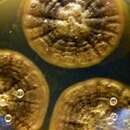en
names in breadcrumbs


Aspergillus calidoustus is a species of fungus in the section Ustus, which grows at 37 °C (formerly called A. ustus, a species that fails to grow at 37 °C) and exhibits high minimal inhibitory concentrations to azoles. It is considered an agent of opportunistic infection.[1][2][3]
Colonies can appear white and progress to brownish-yellow. Curved conidiophores and Hülle cells can be identified. The conidia are echinulated (spiny).
Aspergillus calidoustus is a species of fungus in the section Ustus, which grows at 37 °C (formerly called A. ustus, a species that fails to grow at 37 °C) and exhibits high minimal inhibitory concentrations to azoles. It is considered an agent of opportunistic infection.